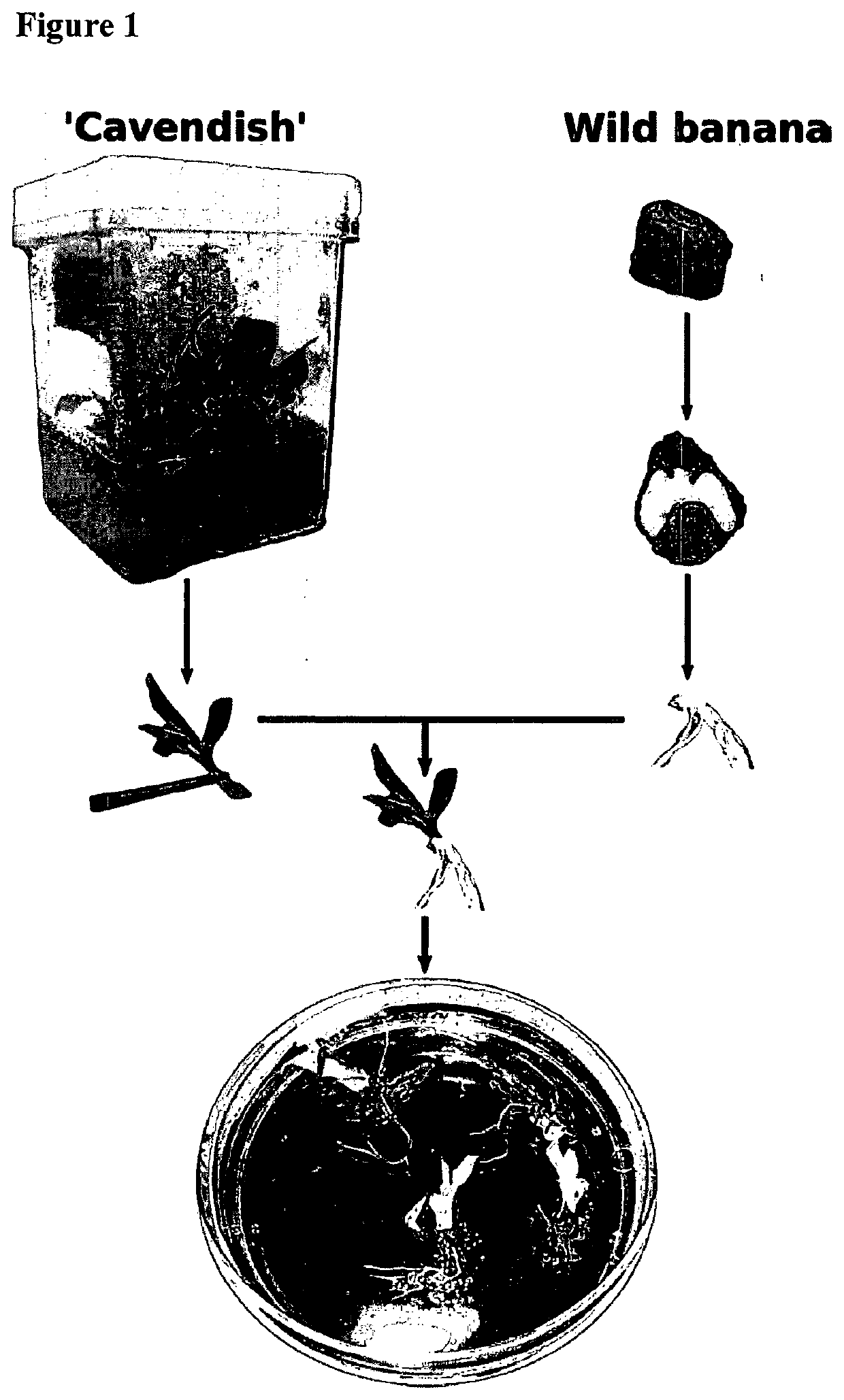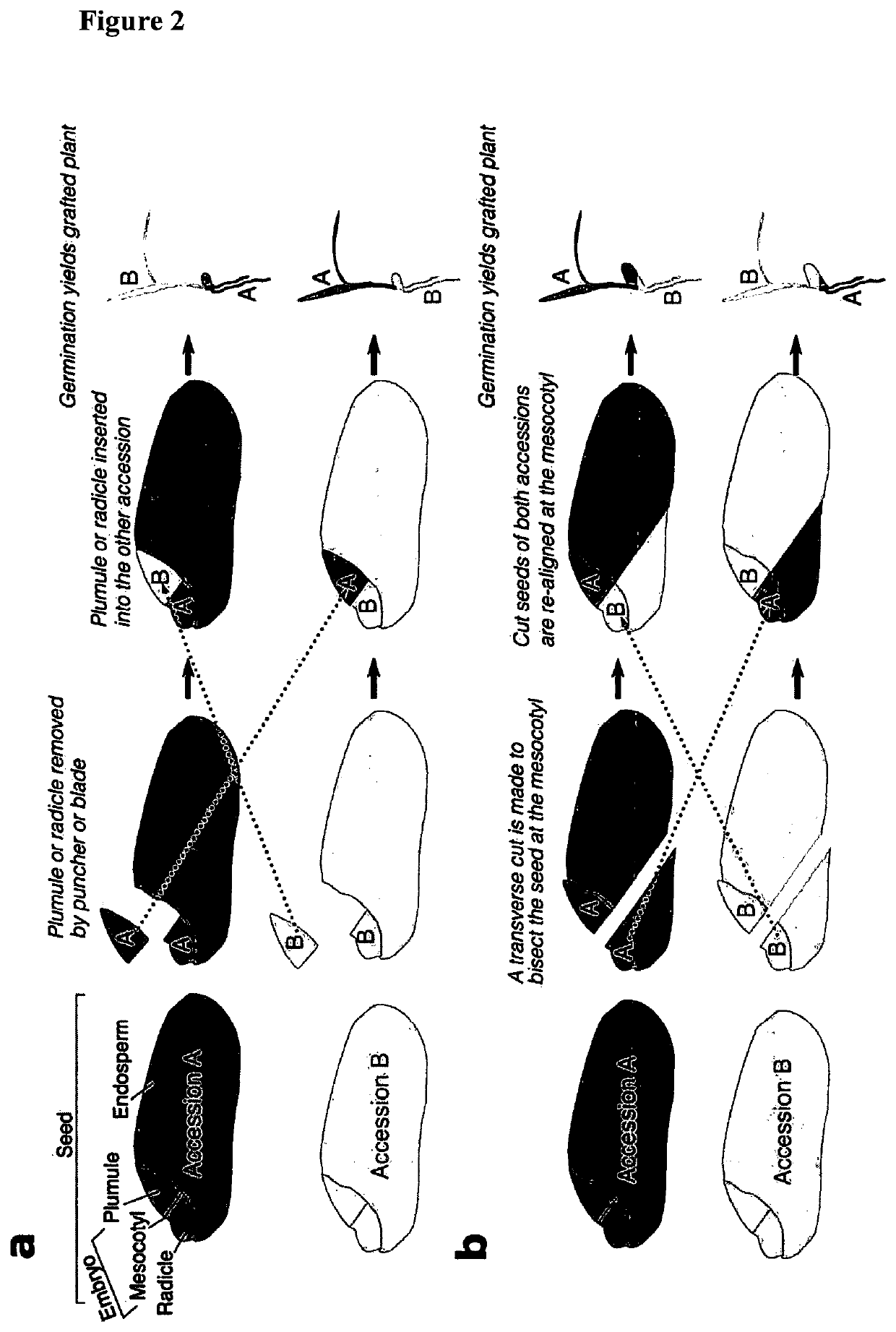Perennial monocotyledon grafting
a monocotyledon and perennial technology, applied in the field of perennial monocotyledon grafting, can solve the problems of difficult propagation, inability to graft monocotyledons, and inability to maintain desirable genotypes, and achieve the effect of low cost and rapid methods
- Summary
- Abstract
- Description
- Claims
- Application Information
AI Technical Summary
Benefits of technology
Problems solved by technology
Method used
Image
Examples
example 1
ting
[0078]Seeds of each palm accession were surface sterilized. In the case of some palms (e.g., oil palm), the outer operculum (a husk-like covering over the seed) was removed with a table vice. Not all palm seeds possess an operculum (e.g., date palm). Seeds were imbibed in sterile water containing 0.01-0.1% (w / v) gibberellic acid (GA3) at 28° C. on a shaker in darkness for 72 hours. The solution was refreshed each day. Gibberellic acid serves to accelerate the germination process. Seeds were then placed on moist filter paper in 9 cm diameter petri plates sealed with micropore tape and kept in darkness at 28° C. Palm seeds were kept in these conditions until germination had proceeded such that the embryonic shoot (plumule) and root (radicle) had emerged from the seed.
[0079]When shoots were 5-20 mm in length, they were cut with a 0.1-0.3 mm razor blade at the interface between the shoot and root (mesocotyl). Rootstocks were obtained in the same manner by cutting the interface betwe...
example 2
afting
[0082]Cultivated banana is infertile and so lacks seeds. It was therefore not possible to obtain embryos and the component parts required for grafting directly. However, young banana shoots formed during micropropagation in tissue culture were compatible with grafting to rootstocks that are derived from embryos of other species, or to rootstocks obtained from micropropagation in tissue culture.
[0083]To obtain shoots suitable for grafting, banana plants (e.g., Musa acuminata ‘Cavendish’) were placed on Banana Shoot Multiplication (BSM) media consisting of 4.41 g·L′Murashige and Skoog salts, 30 g·L−1 sucrose, 100 mg·L−1 ascorbic acid, 6.5 g·L−1 phytagel and 2.25 mg·L−1 N6-benzyladenine (BAP) an artificial cytokinin plant hormone, (pH 5.8) in 9 cm diameter dishes, and sealed with parafilm. Photoperiod was maintained at 16 hours light, 8 hours dark, with a light intensity of 80 μmol photons m−2·s−1. Temperature was maintained at 28° C. Under these conditions, explants continually ...
example 3
Grass Grafting
[0087]Seeds of each grass accession were surface sterilized. They could then either be imbibed in water overnight (8-35 hours) or left dry. A tissue puncher with a 1-1.5 mm (for example 1.2 mm) diameter and 0.1-0.3 mm thick cutting edge was used to bore out the entire plumule and half of the mesocotyl. The mesocotyl was bisected such that half of it is still connected with the plumule and the remaining half is still connected to the radicle of the imbibed seed. The incision was made directly through the seed coat (i.e., the seed coat is not removed beforehand). A 0.1-0.3 mm thick razor / scalpel blade can be used as an alternative tool to excise the plumule.
[0088]The removed plumule was replaced by one from a different seed (either from the same or different species), which can either be dry or imbibed. Dry plumule inserts appeared to absorb water from the imbibed seed causing them to swell, and this generated firm contact with the mesocotyl of the inserted plumule (scio...
PUM
 Login to View More
Login to View More Abstract
Description
Claims
Application Information
 Login to View More
Login to View More - R&D
- Intellectual Property
- Life Sciences
- Materials
- Tech Scout
- Unparalleled Data Quality
- Higher Quality Content
- 60% Fewer Hallucinations
Browse by: Latest US Patents, China's latest patents, Technical Efficacy Thesaurus, Application Domain, Technology Topic, Popular Technical Reports.
© 2025 PatSnap. All rights reserved.Legal|Privacy policy|Modern Slavery Act Transparency Statement|Sitemap|About US| Contact US: help@patsnap.com



